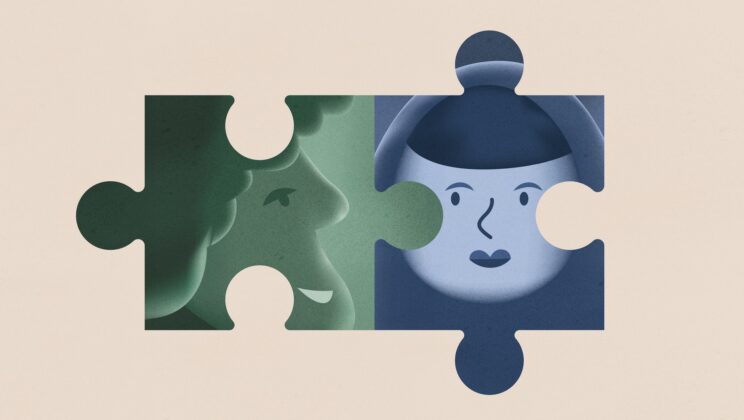Types of Bipolar Disorder: Symptoms and Treatment
March 28, 2023
Bipolar disorder is a mental health condition that causes intense shifts in mood. These changes can affect people’s ability to manage daily life. The disorder may cause people to become euphoric, active, and agitated, or depressed, sad, and fatigued. Some types of bipolar disorder cause shifts back and forth between these states, although some people may experience more of one type than the other or experience them to different degrees.
Bipolar disorder is typically diagnosed during the teen years or early adulthood. If left untreated, the condition can impact nearly every aspect of a person’s life. It can negatively affect their finances and relationships, cause them to behave in ways that don’t align with their values, harm their career, and erode their health. Fortunately, treatment can help people manage the symptoms and lead a healthy, productive life.
What causes bipolar disorder?
The exact causes of bipolar disorder are unknown, but some possible contributors or triggers include:
- Physical brain characteristics
- Chemical imbalance in the brain
- Genetics
- Severe stress
- Drug or alcohol use
- Traumatizing or upsetting events
Types of bipolar
Bipolar disorder is divided into several types, with the main difference being the intensity of the mood swings and how long they last. These include periods of high mood, periods of low mood, and periods in between when symptoms are less apparent.
Bipolar type 1
The main bipolar 1 symptom is a manic episode, or a period of intensely “high” mood. A person experiencing a manic episode might demonstrate symptoms like:
- Needing less sleep
- Talking faster than normal or switching topics quickly
- Experiencing racing thoughts
- Acting distractible, irritable, or jumpy
- Becoming restless or more active than usual
- Showing increased energy
- Engaging in impulsive or risky behavior, such as spending sprees or driving too fast
- Displaying inflated self-esteem
At times it may be hard for people experiencing a manic episode to notice a change in their own behavior, but family, friends, co-workers, or other close connections might.
People with this type of bipolar may also experience what are called hypomanic episodes, which are less heightened forms of a manic episode.
Another common bipolar 1 symptom (though not necessary for a diagnosis), is a major depressive episode. Someone experiencing a major depressive episode is likely to experience a number of symptoms that can impact their ability to function at work, school, or in their personal life, such as:
- Feeling very sad
- Loss of interest in activities usually enjoyed
- Feeling guilty or worthless
- Fatigue
- Sleeping more or less than usual
- Changes in appetite
- Restlessness, or sluggish speech and movement
- Disruptions to concentration
- Suicidal thoughts
Some bipolar 1 symptoms may become severe. For example, a severe manic or depressive episode may trigger psychotic symptoms such as delusions (false beliefs) or hallucinations (seeing or hearing things others don’t see or hear).
Bipolar 1 treatment
Bipolar type 1 can be managed with treatment. Typically, medications such as mood stabilizers, antipsychotics, or antidepressants are needed to help ease bipolar 1 symptoms. Therapy also helps people recognize symptoms and cope with the condition through skills like behavioral activation, managing lifestyle changes (e.g., sleep scheduling), and learning the triggers for their manic or depressive episodes to hopefully reduce their frequency and intensity in the future.
One thing that’s helpful to know is that treatment is typically long term. Bipolar type 1 is not a disorder that will go away, but it can be well-managed through consistent treatment. Many people with bipolar type 1 live full, productive lives, especially when they’ve learned effective coping skills and are consistent with their treatment recommendations.
Bipolar type 2
In general, the high moods of bipolar type 2 are not as intense as those of bipolar type 1. A manic episode is not necessary for diagnosing this type of bipolar. Instead, people with bipolar type 2 experience major depressive and hypomanic episodes.
It’s common for those with bipolar type 2 to have other mental health disorders, such as anxiety or substance use disorders. Often, people with bipolar type 2 symptoms will initially seek treatment for depression because a hypomanic episode may not be immediately recognized as a problem or cause for concern. The depressive episode may be the first symptom that raises a red flag.
Bipolar 2 treatment
Bipolar 2 treatment is similar to bipolar 1 treatment. Medication, therapy, and self-monitoring are all critical pieces of treatment. Similar to bipolar 1 disorder, therapy is an important part of treatment because many people don’t notice the signs of hypomania as readily as they do the signs of depression. Therapists help people better understand their triggers and develop skills to manage their symptoms and lifestyle needs, like sleep, with a goal of reducing the intensity and frequency of hypomanic and depressive episodes.
Cyclothymic disorder
With cyclothymic disorder, the highs and lows don’t last as long and the symptoms may not be as intense as the other types of bipolar. In other words, bipolar mood swings are still there, just on a smaller scale. Treatment is similar to bipolar 1 and 2.
Other types of bipolar disorder
There are a few other types of bipolar disorder. These include:
- Rapid cycling bipolar disorder—This type of bipolar involves several episodes of mania or depression.
- Bipolar with mixed features—Some people experience a mix of both manic and depressive symptoms, either at the same time or in very quick succession. This is distinct from types of bipolar disorder in which mania and depression don’t overlap, or are separated by periods of stable moods.
- Bipolar with seasonal pattern—Changing seasons can affect some people with bipolar disorder. Typically, they experience depressive episodes during the darker, colder months of fall and winter, and manic or hypomanic episodes during spring and summer.
- Bipolar unspecified—Sometimes called bipolar NOS (not otherwise specified), this condition occurs when people experience symptoms of bipolar disorder that can’t be explained by another cause, but don’t meet the criteria for bipolar I, II, or cyclothymia.
Misconceptions about bipolar disorder
As with many mental health conditions, myths about bipolar disorder abound. Here’s the truth about this often-misunderstood diagnosis.
Misconception 1: Bipolar disorder is a rare diagnosis.
Research shows 4.4 percent of adults in the United States experience bipolar disorder in their lifetime. While it isn’t common, it’s impactful on those who do experience it, which is why it's important to get treatment and support.
Misconception 2: Bipolar mood swings happen very quickly.
In fact, manic or depressive episodes often last longer than one might think, especially given how the media talks about bipolar disorder. They come on or resolve slowly, and can be separated by periods where moods remain at baseline.
Misconception 3: People with bipolar disorder are dangerous or violent.
Being manic can lead to impulsivity or irritability, but that doesn’t mean the person is inherently unsafe or violent. In fact, people with a mental illness are far more likely than the general population to be victims of violence than perpetrators.
Misconception 4: Manic periods are fun, productive, or enjoyable.
Mania isn’t just a feeling of euphoria. It can also cause people to become distractible, take unhealthy risks, jump from one idea to another, or have trouble sleeping. Many people find it extremely disruptive to their everyday lives.
Misconception 5: Bipolar type 2 is a less severe condition than bipolar type 1.
People tend to think this because the hypomanic periods of bipolar 2 aren’t as severe as in bipolar 1. However, bipolar type 2 always features depressive episodes and they’re often more severe than depressive episodes in bipolar 1.
Diagnosing bipolar disorder
It's important to get an accurate diagnosis in order to get the right treatment. Unfortunately, bipolar disorder is frequently misdiagnosed, sometimes for years. This is partly because its symptoms overlap with so many other conditions, like ADHD, borderline personality disorder, depression, and schizoaffective disorder. Major depressive disorder can be especially easy to confuse with bipolar disorder because of bipolar’s strong link with depressive episodes.
It can also be tough to give health care providers an accurate assessment of symptoms. If someone is in the middle of a depressive episode, for example, they may not be focused on how they felt the last time they were manic or hypomanic. A doctor who only hears about one portion of the symptoms may miss what’s really going on.
This is why it’s important to carefully note all symptoms and share them honestly with a doctor or psychologist. It can be helpful to involve family or friends in providing information to a practitioner. If you suspect you may have bipolar disorder, seek out a professional who’s experienced at treating it and provide them with a thorough history of your signs and symptoms.
Steps to take in addition to treatment
If you’ve been diagnosed with any type of bipolar, you’ll need to work with a medical practitioner to manage the condition. Additionally, there are things you can do in daily life to help ease the symptoms.
- Learn how to self-monitor. Work with your treating provider to become more aware of the warning signs of a bipolar mood swing. This looks different for everyone, so collaboratively identifying these signs with your provider can feel very empowering.
- Lower stress. Stress contributes to many health challenges, and bipolar disorder is no exception. Try to minimize stress as much as you can and identify what triggers your low or high moods and eliminate those triggers as much as possible. Your provider can help you learn effective ways to manage stress when it does arise.
- Mind your physical health. Things like adequate sleep, regular exercise, and a healthy diet are all helpful in managing mood. Both medical and mental health providers can help you set goals for improving your physical health and tracking the impact that has on your mood.
- Take your medications consistently. Some people with bipolar disorder stop taking their medication once they start to feel better believing they no longer need it. This isn’t the case. Medication is meant to prevent new episodes, so taking it regularly is important. It can actually be dangerous to stop medication without the oversight of a doctor. In addition, bipolar disorder is thought of as a progressive disorder, so adhering to medication is important to prevent bipolar from getting worse over time.
Additional lifestyle steps can include:
- Keeping your sleep routine consistent
- Asking your treating physician before taking a new medication or supplement
- Keeping a mood journal or using a mood tracking app
- Staying in communication with your primary care physician and other treatment providers
- Avoiding alcohol and illegal drugs
- Finding a support network among family and friends
How to help a loved one with bipolar disorder
If you have a loved one who’s been diagnosed with bipolar disorder, you can play an important supportive role in their journey. Bipolar disorder requires therapy and care from a trained clinician. Your support is not a replacement for professional health care; however, finding ways to help your loved one can be a powerful addition to their professional treatment plan.
First, learn the signs and symptoms that may signal the onset of a manic, hypomanic, or depressive episode. Your loved one will likely work with their therapist and psychiatrist or physician to learn these signs themselves, so they may be able to help you understand what to watch out for. It’s ideal if a manic, hypomanic, or depressive episode can be “caught” and addressed early in the cycle.
You can also encourage your friend or family member to follow their professional treatment plan. Especially crucial is attending therapy appointments and taking any prescribed medications as directed.
Even with a good treatment plan and lifestyle changes, you can’t guarantee that symptoms will never become troublesome again. One of the best things you can do is work with your friend or family member to develop an emergency plan. If their symptoms escalate and they become unsafe, what will you do? Who will alert their physician or care team? Planning ahead for this allows your loved one to have control over their care.
Finally, ask your loved one what kind of support they need. There’s no one-size-fits-all roadmap for how to help someone with bipolar disorder. Their treatment team may be able to give them ideas for how to enlist others in supportive ways.
Getting help for bipolar disorder
If you have or suspect you have some type of bipolar disorder, there’s hope. Many people manage the disorder and go on to live happy, productive, and fulfilling lives. To do this, you’ll need to reach out for professional support. You can start your journey toward feeling better today if your employer offers mental health benefits with Lyra Health.
Get professional support for bipolar disorder.
You can get started today if your employer offers Lyra.
Author
Rebecca Cameron
MA, LMHC, LPC
Rebecca is a licensed mental health counselor with Lyra Health and also maintains a private practice. She holds a master’s degree in counselor education from the University of Central Florida and a graduate certificate in play therapy. Her specialties include working with clients that have experienced trauma, eating disorders, bipolar disorder, ADHD, OCD, and anxiety disorders. She has an extensive background in research and education.
Explore additional blogs

Mental health treatment
How Chronic Illness and Mental Health Intersect

Mental health treatment
Should I Go to Therapy? How to Know if It’s Right for You

Mental health treatment